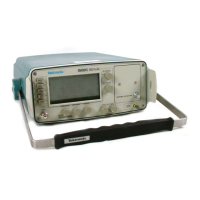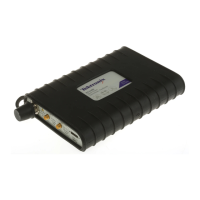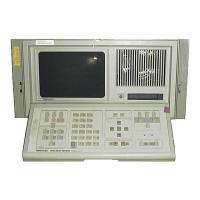Theory of Operation
4–4
1720/1721
the Quad Phase Detector is delayed by 90°. The chrominance signal is compared
to the regenerated subcarrier from the VCXO with the output low-pass filtered
and buffered. The Phase Detector output is clamped and supplied to the Error
Amplifier, which provides an output voltage to correct the VCXO should it be
off frequency.
The Quad Phase Detector compares the burst chrominance to 90° phase-shifted
subcarrier, with the output low-pass filtered and buffered. The resulting signal is
a pulse, when burst is present, that clamps the Phase Detector output. It is also
checked for phase lock and, if unlocked, an output is supplied to the Error
Amplifier to increase its bandwidth for a faster locking. When the TEST (Cal
Mode) is enabled, the Error Amplifier is forced into an unlocked state to provide
the test circles.
The regenerated subcarrier from the VCXO can be phase shifted up to 360° by a
goniometer (front-panel PHASE control) whose output is buffered prior to input
to the Demodulators. The amplitude of the regenerated subcarrier is fed back to
the VCXO through an Automatic Gain Control circuit.
The V-Axis Switcher takes the output of the Phase Detector H Sync and
generates an alternate line signal. The resulting alternate line signal is used to
control the input switching to the Quad Phase Detector. In PAL (1721)
instruments, an additional signal, from the Microprocessor, is used by the V-Axis
Switcher to control the Quad Phase input to the R–Y Demodulator.
The 1720/1721 employs quadrature demodulation, which consists of delaying
the regenerated subcarrier by 90° to the R–Y (U) Demodulator. In the 1721, an
additional 180° phase shift is achieved by switching the regenerated subcarrier to
the –input of the demodulator. The incoming chrominance is compared to the
regenerated subcarrier and the output is low-pass filtered and amplified. Center
Dot clamping is used to keep the effects of chrominance from distorting the
display center dot.
The Vertical and Horizontal Deflection Amplifiers do double duty. They are
used to output both the vector display and the XY display. The input of the
amplifiers is checked for the presence of a signal over a certain amplitude, and
the resulting output is one input to the CRT Blanking circuit. X and Y signals
are input through balanced amplifiers, that can be converted to single-ended high
gain inputs. Input switching is controlled by the Microprocessor and front-panel
switching.
CRT blanking takes inputs from the front-panel INTENSITY control, the
Microprocessor, and the Center Dot Comparators to generate the blanking signal.
In addition, in the Auxiliary mode of operation, a line select strobe from a
companion 1730-Series can drive the blanking amplifier to unblank only the line
or lines that are selected with the waveform monitor’s line selector.
Demodulators
Output Amplifiers
CRT Blanking

